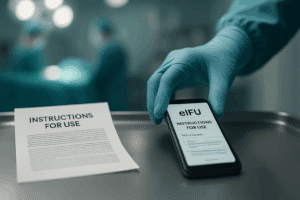Finally, after long months and years of discussion, the EU has relented and extended the applicability of the eIFU Regulation (EU) 2021/2226 to a large number of medical devices. This was made possible by the amending Regulation (EU) 2025/1234, which was adopted in June and came into force in mid-July. There are also relevant changes for manufacturers that do not fall within the amended scope.
The regulatory provisions of the now amended (EU) 2021/2226
Annex I of the MDR gives manufacturers of medical devices the option of making electronic instructions for use available instead of IFUs in paper format under defined circumstances. This Essential Requirement 23.1 f) has referred to Regulation (EU) No 207/2012 since the beginning. However, its successor Regulation (EU) 2021/2226 has been in place since 2021, although its content did not differ greatly from its predecessor. However, following intensive surveys by the EU Commission, particularly among users, EU Commission has endeavoured to adapt the regulation (see recital 2 of (EU) 2025/1234). There have also been various activities and initiatives on the part of manufacturers and interest groups in recent years to persuade politicians to change course. The reasons for this are complex, ranging from language variants for all 24 official languages to sustainability aspects and general customer demand. This has now been taken into account with the amending regulation, which amends almost all articles.
Products and users covered by the regulation
Previously, it was only possible to make electronic instructions for use available for certain products. This was limited to implantable (active) devices, permanently installed devices and devices with a built-in display.
With the amendment, this restriction has been lifted and an eIFU may be used for any type of product, provided that the user is a “professional user”.
The “professional user” is defined as follows in Article 2 of the eIFU Regulation:
‘professional users’ means persons using the device in the course of their work in the framework of a professional health care activity;
This definition is important and should be clearly distinguished from that of a layperson (MDR, Article 2(38)):
“lay person” means an individual who does not have formal education in the relevant field of healthcare or medical discipline
It is important to note that even a trained lay person, for example a family carer, is not a professional user (training and education should not be mixed up!). They remain laypersons and should continue to receive paper-based instructions for use.
MDR Article 2(37): “User” means any healthcare professional or lay person who uses a device;
If a device is intended for both user groups or if each group receives separate information on a device, the part of the information intended for the professional user may be made available purely electronically. However, the part aimed at the lay user must continue to be made available in paper form. This is provided for in the future Article 3:
(2) Where it is reasonably foreseeable that a device intended for use by professional users is also used by lay persons, manufacturers shall provide the instructions for use intended for lay persons in paper form.
Therefore, the definition of “users” is an important aspect from many points of view. In addition to usability, clinical evaluation and risk management, the instructions for use are another area that is influenced.
Furthermore, devices without an intended medical purpose are now also covered by the e-IFU Regulation, which were previously excluded from its scope.
What needs to be considered when introducing the eIFU?
A risk assessment must be carried out as a central element, true to the omnipresent risk-based approach linked to post-market surveillance. The knowledge of professional users must be taken into account (even professional users are not a homogeneous group!). However, risks relating to digital provision or the provision of new versions must also be assessed. The minimum risks to be considered are already set out in Article 4.
The implementation of the eIFU must not only be considered on a risk basis, but must also be verified and validated in terms of its functionality, not forgetting possible influences on hardware and software in the case of electronically integrated IFUs.
Furthermore, specific information (medical emergencies, switching on devices with an integrated display) must continue to be made available in paper form. It must also be clearly recognisable on the label that the product is accompanied by electronic instructions for use. The user must also be able to easily recognise how to contact the manufacturer if they wish to request a printed version. The instructions for use must be made available in a standard, free format. Additional information made available in videos, for example, must not replace content from the IFU. The IFU alone must contain all relevant information in text form.
In addition to the format requirements, manufacturers must also consider the data security of the instructions for use and user data protection.
The introduction of eIFU also requires an adaptation of the quality management system. The relevant processes must be documented and inspected by the notified body. In return, the amending regulation removes the obligation to have the conformity of the eIFU checked by the notified body.
Availability and retention periods
Similar to the retention periods under Article 10(8) of the MDR, under which the eIFU as part of the technical documentation also falls, a retention period of 10 years also applies under the eIFU Regulation. However, this only applies to devices with a defined lifetime. If a product does not have a defined service life or is implantable, the eIFU must be kept for at least 15 years after the last product placed on the market.
However, the amended eIFU Regulation does make things easier at this point: not all versions that have existed in the history of the respective instructions for use need to available on the website at all times. However, they must be made available on request.
The same applies to paper versions: At the request of a user, the manufacturer must be able to make a paper version of the instructions for use available free of charge within 7 days (not working days, but calendar days!). This may still be feasible for customers in Germany, but if the instructions for use have to travel to Bulgaria or another EU country with a long distance, for example, this may well harbour risks in terms of timely delivery.
It should also be noted here that this applies to all language versions of the instructions for use – e-version as well as paper version – so determining the target countries of a device is an important aspect when it comes to defining the device and its variants as well as the UDI assignment. In future, the corresponding internet address, via which the eIFU can be accessed, must also be maintained in the EUDAMED database.
In other words: in the case of an eIFU, the current instructions for use must be available on the homepage in all relevant languages of the EU target countries, it must be possible to make them available in paper form on request and all old versions must be kept in all relevant languages for at least 10 years. Do not forget to update EUDAMED in case of changes!

If the IFU exists in parallel on paper and electronically
The previous version of Regulation 2021/2226 had hardly brought any relief for manufacturers who were not previously covered by the eIFU Regulation but had already made electronic instructions for use available. Now, however, the amendments as per (EU) 2025/1234 make it much easier to offer users this convenience.
In future, the corresponding Article 9 or 8 will simply read:
Instructions for use in electronic form, which are provided in addition to complete instructions for use in paper form, shall be consistent with the content of the instructions for use in paper form.
This will also make it easier for many manufacturers to implement the still very unclear, convoluted requirement in GSPR 23.1 of the MDR:
Each device shall be accompanied by the information needed to identify the device and its manufacturer, and by any safety and performance information relevant to the user, or any other person, as appropriate. Such information may appear on the device itself, on the packaging or in the instructions for use and shall , if the manufacturer has a website, be made available and kept up to date on the website […].
So if you now want to challenge the topic eIFU , then go ahead with defining the product’s user, its lifespan, the target countries for the product and its variants; analyse the associated risks, verify and validate, ensure cybersecurity and GSPR and … or if it doesn’t sound so easy after all, then contact us. The experts at seleon GmbH will be happy to help and advise you.




